国际学术交流英语U2T2
- 格式:ppt
- 大小:824.50 KB
- 文档页数:29
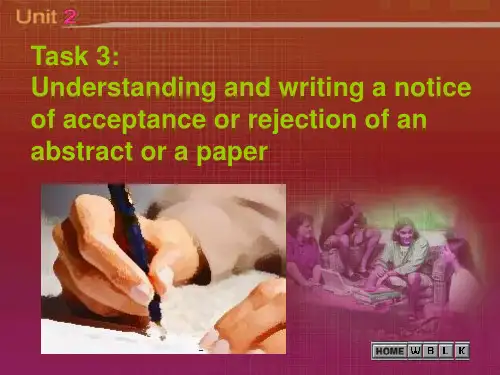

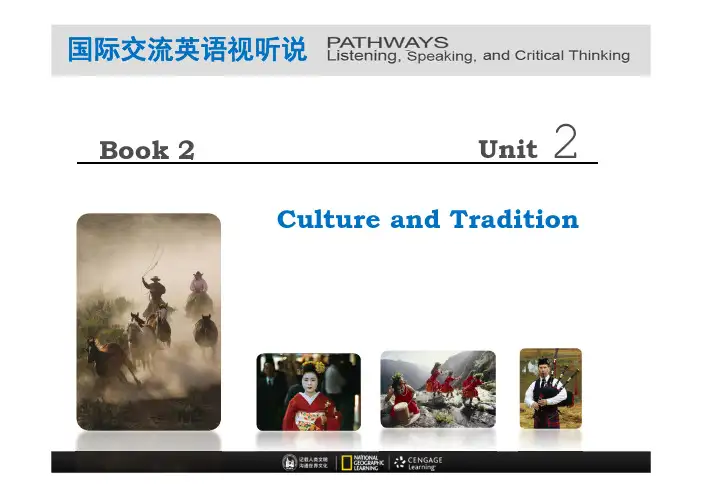
Unit 2Book 2 Culture and TraditionThink and Discuss Viewing the WorldExploring the ThemeAnalytical ListeningSharing Your IdeasEngagingFurther ListeningC ontentUnit 2 Culture and TraditionT hink and Discuss1.Look at the photo. What do youknow about cowboys?2.In which countries do cowboyslive and work?A cowboy and a cowgirlherding horses in Oregon,U.S.AQuestionsQuestions1.Look at the photo. What do you know about cowboys?Example AnswersI know that cowboys ride horses, and their job is to takecare of cows, or cattle. Many cowboys work on ranches,which are farms where cattle and other animals are raised.Questions2.In which countries do cowboys live and work?Example AnswersCowboys live and work in North and South America, from Canada and the U.S.A. to Mexico, Brazil, Argentina, etc.国际交流英语视听说Culture and TraditionUnit 2E xploring the ThemeCulture and Tradition Look at the photos and read the captions. Then discuss the questions.1.Where do these people live?2.How are these people similar?3.What are some cultures that interest you? Why?4.What are some things that make your own culture special?An Argentine gaucho, or cowboy, herdsblack cattle through a field.Culture and TraditionIn Japan, geishas are female entertainers. The wordgeisha means “art person”. Geishas spend a lot of time studying how to perform traditional Japanese music and dances.Culture and TraditionCulture and Tradition The Sherpa people live in Array the Himalayan region. Theword Sherpa means “easternpeople”. The word Sherpaniis used for female Sherpas.guides and help peopleclimb mountains,particularly MountQomolangma.The Roma people lived in India before they moved to Europe. Today,there are many Roma people living in Romania, Hungary, and otherEuropean countries. When Roma children go to a school where people speak a different language, they often stop speaking their Roma language. Scientists estimate that 3,000 languages might disappear in the next 100 years as people stop speaking their native languages.Culture and TraditionCulture and TraditionAborigines are the original people of Australia. There are many different groups of Aborigines living there. Each group has its own language, culture, and customs.In the United States, the Navajo Indians still do their traditional dances, and many speak both the Navajo language and English.Culture and TraditionGauchos are cowboys from Brazil, Argentina, and Uruguay. Gauchos’ work involves moving herds of cattle from one place to another.Culture and TraditionCulture and Traditiongeisha: a woman who works as a traditional Japanese entertainer. Geishas are trained in traditional Japanese arts including singing, dancing, as well as conversation and games. 日本艺妓Culture and TraditionSherpa: a member of an ethnic group living in the Himalayan region. The Sherpas are best-known for their work as expert mountaineers and porters (行李搬运工) who take expeditionsup the mountains in the Himalayas. 夏尔巴人gypsy:a name used to describe a member of the Roma ethnic group. The name comes from a mistaken historical belief that they were Egyptian in origin. The Roma have several different languages and cultures. Most Roma live in Europe, though there are Roma populations in North and South America. 吉卜赛人Culture and TraditionAborigine:a name used to describe people who are historically native to a region. The best-known example is the people who lived in Australia before European settlers arrived. The term “indigenous person” has the same meaning and is usually considered more acceptable. 澳大利亚土著居民Culture and TraditionNavajo Indian: a member of a tribe of native American Indians in the U.S.A. Many Navajo live in the Navajo Reservation ( 纳瓦霍印第安人居留地) which occupies parts of the states of Arizona, New Mexico, and Utah. The Navajo people are famous for their traditional arts and crafts, including weaving and silver jewelry. 纳瓦霍印第安人Culture and Traditiongaucho:a person who rides a horse and works with cattle in parts of South America. Gauchos are famous for their rugged ( 吃苦耐劳的) and independent lifestyle. 加乌乔牧人Culture and TraditionCulture and Tradition 1.Where do these people live?Example AnswersGeishas live in Japan.The Sherpa people live in the Himalayan region.The Roma people live in Romania, Hungary, and other European countries.Aborigines live in Australia.The Navajo Indians live in the United States.Gauchos live in Brazil, Argentina, and Uruguay.Culture and Tradition 2. How are these people similar?Example AnswersThese people represent old cultural traditions in the placeswhere they live. They also represent smaller culturalgroups—not huge populations.Culture and Tradition 3. What are some cultures that interest you? Why?Example Answers• I’m interested in the Hawaiian culture because I think huladancing is beautiful and the Hawaiian Islands are verybeautiful.• I’m interested in the Sami people of Scandinavia because they herd reindeer, their culture and language are very old,and their customs are disappearing quickly.• I’m interested in the culture of Sri Lanka because it has been influenced by several ethnic groups, including theSinhalese (僧伽罗人), Tamil (泰米尔人), etc.Culture and Tradition 4. What are some things that make your own culture special?Example AnswersMy own culture, Chinese culture, is special because it is soancient. Its history goes back thousands of years. Chineseculture is also special because China covers such a largegeographical area, and Chinese food, customs, andlanguages have traveled to many places, includingSingapore, Indonesia, and Malaysia, to name a few.国际交流英语视听说A nalytical ListeningUnit 2Culture and TraditionRobb Kendrick 罗布·肯德里克(人名)Tyrel Tucker 蒂雷尔· 塔克(人名)ranch n. 大牧场Wyoming 怀俄明州(美国西部州)Manuel Rodriguez 曼努埃尔·罗德里格斯(人名)Coahuila 科阿韦拉州(墨西哥东北部州)La Mora Ranch 拉莫拉农场Listening 1Listening 1vaquero: a Spanish word used to describe a man who rides a horse and works with cattle. The vaquero style of working with cattle came historically from Spain to Mexico and spread to California, New Mexico, and Texas in the U.S.A. 牧牛人charro: a kind of traditional cowboy from Mexico. Thecharros are best-known for their colorful hats and clothes, and for their traditional Mexican rodeos (牛仔竞技表演), called charreadas . 墨西哥牛仔Listening 1Prior Knowledge. Discuss the questions with a partner.Before Listening Listening 11.What do you know about cowboys’ lifestyle?2.Besides North America, do you know of any other regions that have cowboys? What arethey called in those places?Cowboy still work onranches in the westernUnited StatesListening 11.What do you know about cowboys’ lifestyle?Example AnswersThe lifestyles of cowboys involve being away from home for long periods, riding horses, and living and working with cattle outdoors.Listening 12. Besides North America, do you know of any other regions that have cowboys? What are they called in those places?Example AnswersBesides North America, there are cowboys called gauchos who live in Argentina, Brazil, and Uruguay. Other cowboys called paniolos live in Hawaii, and vaqueros live in Mexico.A |Listening for Main Ideas.Listen to the first part of the lecture and check(√) the main idea you hear.A LectureListening Listening 1☐The last cowboys disappeared a long time ago.☐Fewer young people want to be cowboys because of the money matters.☐In some parts of the world, there are still traditionalcowboy customs.√Listening 1Professor Daley: OK, so let’s continue. A lot of people today think that the last cowboys disappeared a long time ago. It’s true that there are fewer cowboys today, and the cowboy way of life is endangered. Money is a big factor here. Cowboys usually don’t make a lot of money for all the hard work they do, so fewer young people today want to be cowboys—it’s not an easy lifestyle. Even so, in some parts of the world, cowboys still ride their horses, watch the cattle, and practice traditional cowboy customs.B | Listening for Details.Listen to the entire lecture and complete the notes about the two cowboys.Listening 1•________ years old when the photo was taken•got his first horse when he was_________________•one winter, he worked alone with his_______________ on a ranch •took care of _________ cattle •lived in a shack with no ___________•_____________ the work Tyrel Tucker18two years old older brother2,300electricity enjoyedListening 1 •started working with his father whenhe was _______________•_________ generations of his familyhave worked on the same ranch•got ____________ and moved to thecity•wants to ______________ to thecountryside and work as a vaquero again Manuel RodriguezB| Listening for Details.Listen to the entire lecture and complete the notes about the two cowboys.four years oldfourmarriedmove backC| Making Inferences. Read the statements. Then listen again and check (√) T for true or F for false. The statements are not in the professor’s exact words. You need to think about what you hear.Listening 11. Tyrel liked school.2. Tyrel and his brother ate a healthy diet.3. Both Tyrel and Manuel would be very unhappy living in a big city.4. The two men want to get better jobs.T F ☐☐☐☐☐☐☐☐Listening 1Example Answers1. F (He was happy to leave school at the age of 17.)2. F (They ate the same few foods every day, and didn’t eatvegetables or fruits.)3. T4. F (Tyrel enjoys cowboy work, and Manuel plans to work as acowboy again after his first child is born.)Listening 1D| Discussion. Read the questions. Then listen again and discuss the questions with your partner.1. When did the cowboy tradition start in Mexico? Why?2. Who did the Mexican vaqueros used to work for?3. What did the Mexican vaqueros wear? For whatreasons did they wear those clothes?4. Which part of America did the Mexican cowboys firstmoved into?5. How many kinds of cowboys are there in Mexico today?What are they?Listening 11.When did the cowboy tradition start in Mexico? Why?Example AnswersThe cowboy tradition in Mexico started in the 1600sbecause Spanish people brought cattle to the NewWorld. Workers are needed to take care of the cattle.Listening 1 2. Who did the Mexican vaqueros used to work for?Example AnswersThe Mexican vaqueros used to work for people whoowned big ranches.Listening 13. What did the Mexican vaqueros used to work for?Example AnswersThe Mexican vaqueros used to wear big hats to keep the sun off their faces and high boots to protect their legs.Listening 1 4. Which part of America did the Mexican cowboys firstmoved into?Example AnswersThe Mexican cowboys first moved into Texas in the southern U.S.A.Listening 15. How many kinds of cowboys are there in Mexico today?What are they?Example AnswersThere are two kinds of cowboys in Mexico today. Onekind, called charros, ride horses and compete in sports.The other kind, called vaqueros, work with cattle on the ranches.Critical Thinking.Form a group with two or three other students. Discuss the questions.Listening 1After Listening 1. Why do you think Robb Kendrick used an old kind of camera for his pictures?2. What kinds of people want to be cowboys now?3. Why do you think they like the cowboy’s way of life?4. Would you like this way of life? Why or why not?5. Are there cowboys in China? If yes, what is their way of life like?Listening 11. Why do you think Robb Kendrick used an old kind of camera for his pictures?Example AnswersRob Kendrick used an old camera probably becausecowboy work is an old tradition, and Kendrick wantedthe photos to look old-fashioned, not modern.Listening 1 2. What kinds of people want to be cowboys now?Example AnswersPeople who want to be cowboys now probably likeanimals and enjoy working outdoors, and they don’t expect to make a lot of money or live in luxury.Listening 1 3. Why do you think they like the cowboy’s way of life?Example AnswersThey probably like the cowboy’s way of life because they have a love for freedom.Listening 1 4. Would you like this way of life? Why or why not?Example Answer 1Yes, because I’d like to seek a life of loneliness in the wild nature. I also like freedom and enjoy workingoutdoors, so the cowboy lifestyle would work for me.Listening 14. Would you like this way of life? Why or why not?Example Answer 1No, because it’s important to me to earn enough money to save and invest. I need to live with my family, so the cowboy lifestyle wouldn’t work for me.。



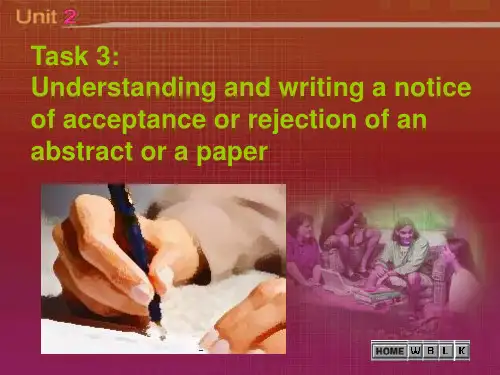
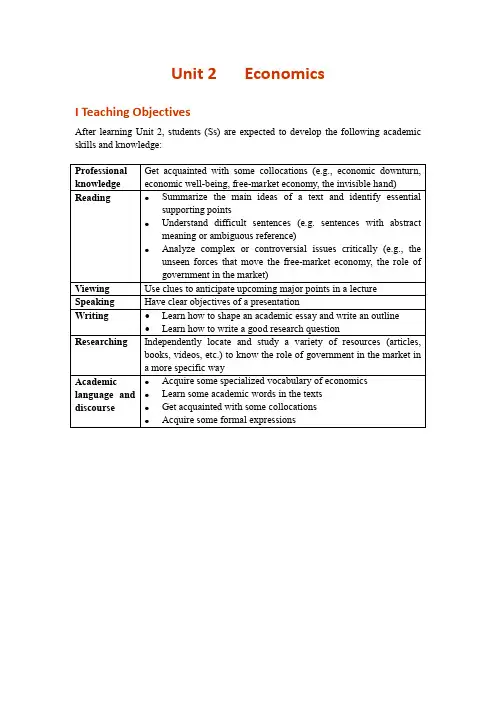
Unit 2 EconomicsI Teaching ObjectivesAfter learning Unit 2, students (Ss) are expected to develop the following academic skills and knowledge:II Teaching Activities and ResourcesReadingText ALead-inTeaching StepsAsk Ss to work in pairs and do the task in Lead-in. Then invite several Ss to share their answers with the whole class.Answer Keys1.The invisible hand.2.Our economic life is made possible by the skill and labor of vast numbers of totalstrangers.The activities of countless far-flung men and women have to be intricately choreographed and precisely timed. However, no one coordinates it, and yet they do cooperate. It’s “the invisible hand” —the mysterious power that leads innumerable people, each working for his own gain, to promote ends that benefit many. Out of the seeming chaos of millions of uncoordinated private transactions emerges the spontaneousText AnalysisTeaching Steps1.OverviewAsk Ss to preview Text A before class. Or, allocate some time for Ss to read the text quickly in class. Then invite several Ss to summarize the main idea of Text A.2.In-Depth Analysis1)Show Ss the following words and ask them to contribute to the class as muchas possible with what they know about these words. Provide additional information in Supplementary Information when necessary.•the invisible hand•free-market economy•economic downturn•An Inquiry into the Nature and Causes of the Wealth of Nations2)Explain some important language points in Language Support to Ss.3)Discuss with Ss the invisible hand in the author’s eyes by doing Task 1 inCritical reading and thinking.4)Organize a group discussion about the questions from Task 2 in Criticalreading and thinking. Encourage Ss to think independently, critically and creatively and share their ideas with each other.Supplementary Information1.free-market economyIn a free market economy, the laws and forces of supply and demand, rather than a central government, regulate production and labor. The prices for goods and services are self-regulated by buyers and sellers negotiating in an open market.Most companies and resources are not owned by the state. Instead, they are owned by private individuals or entities who are free to trade contracts with each other. 2.economic downturnAn economic downturn is a general slowdown in economic activity over a sustained period of time. It occurs when the value of stocks, property, and commodities fall, productivity either grows more slowly or declines, and GDP shrinks, stands still or expands more slowly. It can happen in a specific region (e.g.the Asian financial crisis in the late 1990s) or on a global scale (e.g. the global financial crisis in the late 2000s). The main features of an economic downturn include rising unemployment, falling share and house prices, low consumer confidence and declining investment.4.An Inquiry into the Nature and Causes of the Wealth of Nations(《国富论》)An Inquiry into the Nature and Causes of the Wealth of Nations, usually abbreviated as The Wealth of Nations, is Adam Smith’s masterpiece. It was first published in 1776, and is widely considered to be the first modern work in economics. Through reflection over the economics at the beginning of theIndustrial Revolution, the book touches upon broad topics such as the division of labor, productivity and free markets.Language Support1.Individual buyers and sellers will act according to what is in their own bestinterests. (Para. 2)The phrase “in one’s interest” means “for one’s benefit or advantage”(为了……的利益;为……着想). There are some relevant expressions, such as “in the interest of one”, “in one’s own interest”, and “in one’s best interest”.e.g. It’s obviously in their interest to increase profits.I suspect it’s in your own best interest to quit now.2.Customers are likewise typically looking out for their self-interests. (Para. 4)The word “likewise” is used to signal a comparison that explains how things are similar(同样的;此外).e.g. In this episode, we will likewise deal with another extremely commonquestion.Just water these plants twice a week, and likewise the ones in the bedroom.Other special words and expressions are often used to signal the comparison of two or more people, places, things, ideas, etc. Here are some examples of these signposts for your reference:similarly, both, just as, and also, resemble, parallel, in the same manner, inthe same way, alike, equally3.The market becomes more efficient as buyers and sellers move in the samedirection—as if directed by an invisible hand. (Para. 5)这里的as if用于省略句。
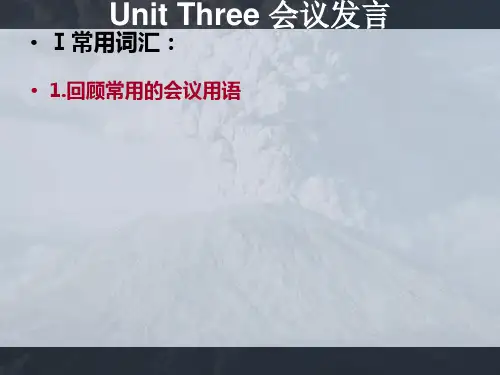
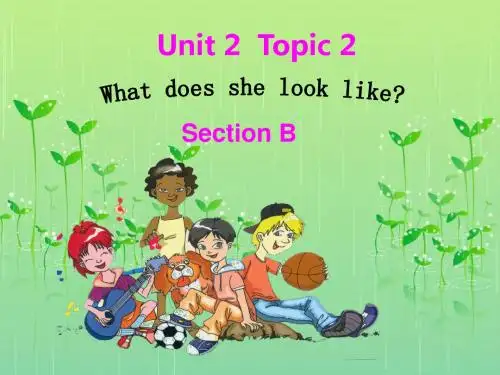

九年级上英语U2T2知识点Unit 2, Topic 2: Exploring KnowledgeIn the second topic of Unit 2 of our 9th-grade English module, we dive deeper into the world of knowledge and explore some fascinating concepts. Knowledge is the foundation of human progress and understanding, and through this topic, we are encouraged to expand our horizons and embrace a thirst for knowledge in various fields.The first aspect of knowledge that we will explore is the power of language. Language is not merely a means of communication; it is a tool that shapes our thoughts, emotions, and perspectives. It is through language that we can express our ideas, engage in debates, and ultimately learn from one another. By understanding and utilizing the power of language effectively, we can open up doors to new opportunities and bridge the gaps between cultures and societies.Moving on, we delve into the intriguing world of literature and its influence on our understanding of the human condition. Literature offers a window into the lives, experiences, and imaginations of people from different times and places. It enables us to explore diverse perspectives and emotions, ultimately broadening our empathy and understanding of the world around us. Whether we are reading classicnovels, contemporary poetry, or thought-provoking essays, literature challenges us to think critically and encourages us to question the status quo.Furthermore, the study of history broadens our knowledge and helps us comprehend the lessons of the past. History is not just a collection of dates and events; it is a reflection of human achievements, struggles, and our shared heritage. Through the study of history, we can gain valuable insights into the mistakes and triumphs of those who came before us. It reminds us of the importance of learning from the past to shape a better future.Science, with its inherent curiosity and constant quest for knowledge, also plays a pivotal role in our understanding of the world. Scientific discoveries and advancements have shaped the course of human civilization. From the understanding of natural phenomena to the development of life-saving medical treatments, science offers us endless possibilities for growth and progress. By nurturing a scientific mindset, we not only stay informed about the latest breakthroughs but also develop critical thinking skills necessary to navigate the complex world around us.Last but certainly not least, mathematics, often considered a precise and structured discipline, fosters logical thinking and problem-solving abilities. Mathematics is the language through which we can understand and describe the underlying patterns and principles in the universe. From the laws of physics to the algorithms that power our technology, mathematics provides us with the tools to unravel the mysteries of the world and make sense of its intricate complexities.In conclusion, Unit 2, Topic 2 of our 9th-grade English module immerses us in the vast realm of knowledge. From the power of language to the influence of literature, history, science, and mathematics, we are reminded of the boundless opportunities for learning and growth that await us. By embracing a lifelong pursuit of knowledge, we empower ourselves to become active participants in shaping a brighter and more enlightened future for all.。
通用学术英语unit2词汇表Unit 2 Petroleum IndustrySection 1 VocabularyText AWordsmulti-faceted ['m?lti,f?sitid] adj.多方面的;多才多艺的encompass[?n'k?mp?s; en-] vt.包含refinement [r?'fa?nm?nt] n.[油气] 提纯subdivision [s?bd?'v??n] n.细分;再分成的部分upstream [?p'strim] n.上游部门chronological [kr?n?'l?d??k(?)l] adj.按年代顺序排列的stabilized [s'te?b?la?zd] adj. 稳定的condensate [k?n'd?nset] n.冷凝物;浓缩物sniffer [sn?f?] n.嗅探器(捕捉局域网数据信息,分析统计,数据自由导进导出, 动态分析,对查找敏感数据、恶意攻击等有很好的帮助作用。
)thumper trucks n. 桑普卡车hydrophone['ha?dr??fo?n] n. 水中听音器(用于接收水声信号的水声传感器。
)warrant [?w?:r?nt] vt.保证,担保seismic [?sa?zm?k] adj. 地震的yield 英[ji:ld] 美[jild] vt. 产生blurred bl?d] adj.模糊不清的feature 英['fi?t??] 美['fit??] vt.以…为特色vertically ['v?t?kli] adv.纵向地,垂直地integrated ['?nt?ɡret?d] adj. 综合的;完整的segment ['s?ɡm?nt] n.部分adversely [?d'v?sli] adv.不利地refinery [r?'fa?n?ri] n.精炼厂;提炼厂;冶炼厂impurity [?m'pj?r?ti] n.杂质;不纯convert [k?n'v?t] vt. 使转变;转换…;imperative [?m'p?r?t?v] adj.必要的,势在必行的pollutant [p?'lut?nt] n.污染物asset ['?s?t] n.资产,财产customized['k?st?ma?zd] adj.定制的;用户化的prowess ['pra??s] n.英勇;超凡技术niche [ni?] adj.有利可图的innovative ['?n?vet?v] adj. 革新的,创新的opportunistic [,ɑp?tu'n?st?k] adj.机会主义的;投机取巧的renaissance ['r?n?sɑns] n.新生;再生asphalt ['?sf?lt] n.沥青;柏油lubricant ['lubr?k?nt] n.润滑剂;润滑油pharmaceutical [,fɑrm?'sut?kl] n.药物antifreeze ['?nt?friz] n. [助剂] 防冻剂propane ['pro'pen] n. [有化] 丙烷synthesize ['s?nθ?sa?z] vt.合成;综合regimented ['r?d??m?nt?d] adj.统一的,受管制的naphtha ['n?fθ?] n.石脑油kerosene ['k?r?sin] n.煤油derivative 英[d?'r?v?t?v] 美[d?'r?v?t?v] n. [化学] 衍生物,派生物seasonality [,siz?'n?l?ti] n.季节性optimal ['ɑpt?ml] adj.最佳的;最理想的revenue ['r?v?nu] n.税收hemisphere ['h?m?sf?r] n.半球Phrases and Expressionsexploratory well探井,探勘井(para.6)core sample矿样,岩心样品(para.7)plug up 堵塞,塞紧(para.7)generic term 通用术语(para.9)takeaway message 结论(para.10)water vapor水汽;水蒸气(para.12)hydrogen sulfide[无化] 硫化氢(para.12)production site 生产现场(para.13)growth boom 发展与繁荣(para.15)crude blend 混合原油(para.16)value chain 增值连锁图表(para.17)shale plays 页岩油气藏(para.17)retail outlet 零售商店(para.18)process hazard analyst 过程风险分析师(para.21)tax accountant 税务会计师(para.21)plant operator 装置操作工,设备操作员(para.21)maintenance supervisor 维修主管(para.21)contracts manager 合同经理(para.21)instrument engineer 仪表工程师(para.21)residual fuel oil 渣油(para.22)Text BWordsConcawe欧洲石油化工协会Solvent ['sɑlv?nt] n.溶剂panoply ['p?n?pli] n.全副甲胄,全副装备(常作比喻)Babylonians [,b?bi'l?unj?nz] n. 巴比伦人(Babylonian的复数形式)Byzantine [ba?'z?nta?n; 'ba?z?nta?n] n.拜占庭人,拜占庭派的建筑师Incendiary[?n's?nd??ri] adj.放火的,纵火的Barbados [bɑ:'beid?uz] n.巴巴多斯(拉丁美洲国家)Seneca ['s?n?k?] n. 塞内卡族(位于纽约西部)ointment ['??ntm?nt] n.药膏;[药] 油膏propel [pr?'p?l] vt. 推进;驱使;激励[过去式、过去分词propelled 现在分词propelling ] potpourri [,pop?'ri] n.混合物bond [bɑnd] n.[化]键methane ['m?θen] n. [有化] 甲烷;[能源] 沼气ethane ['?θen] n.乙烷propane ['pro'pen] n.丙烷butane ['bj?ten] n. 丁烷heptanes ['h?pten] n.庚烷octane ['ɑkten] n.辛烷catalyst ['k?t?l?st] n. [物化] 催化剂olefin ['??l?f?n] n.烯烃aromatic [,?r?'m?t?k] n.芳香族环烃polymer ['pɑl?m?] n. [高分子] 聚合物ethylene ['?θ?lin] n.乙烯propylene ['prop?lin] n. [有化] 丙烯(等于propene)vinyl ['va?nl] n.乙烯基polypropylene ['pɑl?'prop?'lin] n. [高分子] 聚丙烯isopropyl [,a?s??'pr??pa?l; -p?l] n. [有化] 异丙基benzene ['b?nzin] n. [有化] 苯toluene ['tɑlj?,in] n. [有化] 甲苯xylene ['za?lin] n. [有化] 二甲苯polystyrene [,p?l?'sta?ri?n] n. [高分子] 聚苯乙烯utensil [j?'t?nsl] n.用具,器皿styrofoam ['sta?r?,fom] n.泡沫聚苯乙烯polyurethane [,pɑl?'j?r?θen] n.聚氨酯polyester [,pɑl?'?st?] n. 聚酯destabilizing [di:'steibilaiz??] adj.不稳定的ethanol ['?θ?n?l] n. [有化] 乙醇,[有化] 酒精biodiesel ['ba?odizl] n.生物柴油Phrases and ExpressionsSt. Quirinus 圣奎里纳斯(para. 5)Petroleum jelly 凡士林(vaseline)(para. 6) unsaturated carbon bond 不饱和碳键(para. 16) rubbing alcohol 外用酒精(para.17)furniture foam 海绵(家具用)(para. 18)Text CWordsperipherally [p?'r?f?r?li] adv.周边地,外围地divest [da?'v?st] vt.剥夺,迫使放弃embattled [?m'b?tld] adj.心烦意乱的equity ['?kw?ti] n.公平,公正redeploy ['rid?'pl?i] vt.重新部署vacate [v?'ket] vi.空出,腾出incumbent [?n'k?mb?nt] n.在职者;现任者infrastructure ['?nfr?'str?kt??] n.基础设施;公共建设rosy ['rozi] adj.乐观的turbo ['t?bo] n.涡轮增压机premium ['prim??m] n. 额外费用;奖金forefront ['f?rfr?nt] n.最前线,最前部intermediate [,?nt?'mid??t] adj.中级的rejuvenating [r?'d?uv?net??]adj.更新的,复原的fractionators ['fr?k??n,et?] n.分馏器retool [,ri'tul] v.更换机械设备augment [?ɡ'm?nt] vi. 增加;增大aggregate ['?ɡr?ɡ?t] adj.总计的,合计的Phrases and ExpressionsKanata energy group卡纳达能源集团(title)equity stake 股权(para.4)spin off 甩掉(para.4)equity capital 权益资本(para. 7)gas plant 煤气厂,[油气] 天然气加工厂(para.10) even out使(表面等)平坦(或平滑),使平整(para.14) scale up 按比例放大;按比例增加(para.16)take over control 接管(para.18)cubic feet [计量] 立方英尺(para.18)shale gas页岩气(para.19)at full capacity 以全部力量;满功率,满负载(para.21)。
Keynotespeakern.主讲人;大会发言人;Prospective[pr?u'spektiv]adj.未来的;预期的n.预期;展望Ongoingadj.不间断的,进行的;前进的Bearvi.承受;结果实vt.忍受;具有;支撑Sincerity[s?n'ser?t?]n.真实,诚挚Attendees[?'t?n'di]n.出席者;在场者Letterheadn.信头Salutation['s?lj?'te??n]n.称呼;问候;招呼;寒喧Flushvt.abbr.Tonen.Chairasession 主持一个会议Interchangevt.(指两人等)互换vi.交换;n.互换;立体交叉道Paneln.座谈小组,全体陪审员Preparatory[pr?'p?r?t?ri]adj.预备的n.预科;预备学校Symposium[s?m'poz??m]n.讨论会,座谈会;专题论文集;Coveredadj.覆盖了的;隐蔽着的;有屋顶的Reimburse[,ri?m'b?s]vt.偿还;赔偿Subsidizedadj.补贴的,补助的Subsistenceallowance[s?b's?st?ns][?'la??ns]n.预付给新进员工的钱;生活津贴Duration[dj?'re??(?)n]n.持续Registration[red??'stre??(?)n]n.登记;注册;挂号Coordinator[k??'?:d?ne?t?]n.协调者Promptly['pr?m(p)tl?]adv.迅速地;立即地;敏捷地Familiarize[f?'m?l??ra?z]vt.使熟悉Courteous['k?t??s]adj.有礼貌的;谦恭的Alternative[?l't?n?t?v]adj.供选择的;选择性的;交替的n.二中择一Confirm[k?n'f?m]vt.确认;确定;证实;Participation[pɑr,t?s?'pe??n]n.参与;分享;参股Commitment[k?'m?tm?nt]n.承诺,保证;委托;Prohibitive[pr?'h?b?t?v]adj.禁止的,禁止性的;抑制的Colleague[?k?li:ɡ]n.同事;同行Task3Viaprep.VImpactn.Decode[Trackv.跟踪,追踪Manuscript['m?njuskr?pt]n.手稿;原稿。